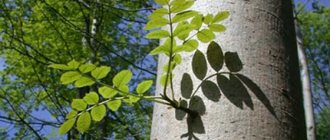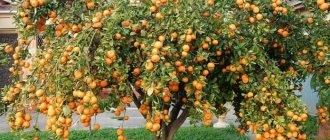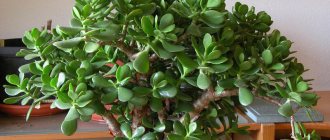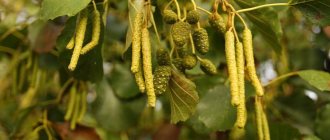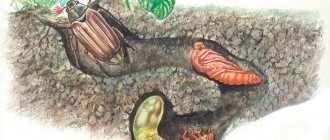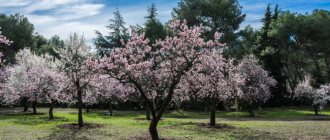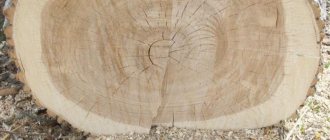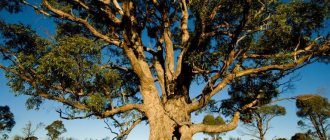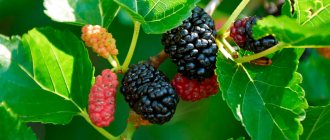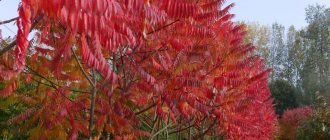Breadfruit or jackfruit
Breadfruit can also be called jackfruit in another way. The tree belongs to the mulberry family and grows in the tropics. They learned to use it a long time ago, and now the exotic is actively spreading around the world.
Why is it called that?
As early as the 17th century, tribes in Polynesia consumed jackfruit as a substitute for bread. After a severe famine began in Jamaica, the country's authorities decided to grow breadfruit throughout the country.
The famous Bounty ship was sent on this mission to the island of Tahiti, from where the crew had to load plant seedlings. However, the project failed, there was a riot on board, and the ship never arrived at its destination.
It was after these events that the unusual exotic plant was first called “grain plant”.
Breadfruit
The ripe yellow-brown fruits are very large, weighing 3 kilograms each, look like large pears and reach up to 30 centimeters in length.
Inside the fruit there is white soft pulp, the seeds are also white. One tree can produce almost 200 fruits over the entire season. The fruits are eaten in different forms.
The benefits of the fruits are great: they can be baked, boiled or dried in the form of crackers. Pancakes, pancakes and pastries are prepared from their pulp.
Attention! The tree can bear fruit without interruption for 9 months in a row.
Description of the taste of breadfruit
The taste of raw breadfruit is very sweet, reminiscent of ripe, very sweet melon and banana.
But fried fruits taste similar to regular baked potatoes.
Where does breadfruit grow?
Jackfruit grows in the tropics of eastern Africa, eastern Asia, and the Philippines. Rarely found in India, where it is a very popular and valuable fruit. However, scientists consider New Guinea to be the birthplace of jackfruit.
What does breadfruit look like?
Breadfruit is an exotic plant with large oval and pear-shaped fruits.
The tree is very tall, in its natural state it grows up to 25 meters in height. Its appearance resembles oak, with smooth gray bark. The branches can be either thick or thin, at the ends of which there are bunched foliage. The leaves have different shapes: old leaf blades are whole, while young ones are dissected.
Note! Depending on the area where it grows, the plant may be evergreen or lose its leaves during leaf fall in the fall.
Varieties
There are several popular types of breadfruit, the fruits of which are distinguished by good taste. These include:
- Jackfruit
- Chempedak
- Marang
Jackfruit is grown in Asian countries, the Philippines, and India. It is the largest fruit that grows on trees. Its size can reach one meter or more. The weight of the fetus is often more than 30 kg. The special thing about jackfruit is that it has a sweet taste that is compared to melon and banana. To get enough of the fruit, just a few pieces are enough. When cut, the fruit emits a rich aroma.
Chempedak has a delicate creamy taste. Its pulp is soft, melting in the mouth. The fruit is grown in Thailand, Malaysia, Brunei. When the peel is peeled, the edible part is revealed, consisting of vanilla-colored segments.
Marang grows on the islands of Borneo, Mindanao, Palawan, and the Philippines. The fruits are oval-shaped, up to 20 cm in length. The edible part is very sweet and juicy. Marang is completely covered with brown spines, under which there are white glossy pieces of pulp. According to tourists' descriptions, this is one of the most delicious exotic fruits.
How to grow breadfruit from a seed at home
To grow jackfruit at home, it is important to maintain regular watering and high humidity levels. The tropical plant does not like high temperatures and dry climate conditions. Low temperatures and frosts are also harmful to healthy growth. In the northern regions of Russia and Siberia, the plant will not take root and will not grow.
It is better to grow jackfruit in a special cabinet called a “Growbox”. The unusually named structure is a small greenhouse with ideal conditions for the growth of exotic plants. It will save a lot of time and make maintenance much easier.
Growing breadfruit from seeds
A description of how to grow jackfruit at home from seeds cannot be called complicated, nor is the growing process itself.
Attention! First, you need to remove the seeds from the fruit and place them in water for one day. Sow one seed in a small pot to a depth of no more than 3 centimeters. After this, the soil in all pots is lightly watered and placed in a room with a temperature of no more than 26 degrees.
It is necessary to constantly moisten the soil in pots. As soon as 4 leaves appear on the ascended trunk, the seedlings are transplanted into larger containers.
Saplings in a pot
Growing indoors
Only a special variety of Jackfruit is suitable for growing indoors, the fruits of which can weigh 18 kg. The height of a home tree reaches no more than 2 m. To grow this plant in the house, it is advisable to first purchase a special cabinet called a GrowBox, which will help create an optimal climate.
A grow box is necessary for growing a tree; in other conditions it will not take root.
Jackfruit cuttings do not root well. It is advisable to grow it only from seeds. But the fruits of this plant are extremely rarely sold fresh, because they are unsuitable for export. For this reason, it is possible to obtain seed material only when visiting one of the tropical countries where this tree is found.
Seeds extracted from fruit remain viable for a month. They must be selected only from ripe fruits in quantities of several pieces.
Landing
Prepare a spacious pot with drainage holes and prepare the soil mixture by mixing 2 parts peat and sand, 1 part humus. Before planting, seeds should be washed to remove pulp, soaked in warm water for a day, and then dried at room temperature.
Landing is carried out as follows:
- A layer of expanded clay is laid on the bottom of the pot.
- The soil mixture is moistened and placed in a container.
- Seeds, one per pot, are buried 2 cm into the soil.
- The soil is moistened, and the containers are moved to a room with a temperature of +27 ºС.
For 20-60 days, it is necessary to ensure that the soil is always slightly moist. With the appearance of four leaves, the seedlings are transplanted into spacious containers with fresh soil mixture. The procedure is carried out carefully, trying not to damage the fragile root system.
This tropical plant requires special conditions when grown indoors. It does not tolerate frost and drought, but at the same time feels comfortable at a temperature of +40ºС. In summer, it is recommended to move the pot to the balcony or terrace. Since the tree is light-loving, there is no need to shade it from the sun's rays. In winter, it is left in a warm room, but away from heaters. The thermometer in the room should not drop to +5ºС.
Watering is regular, but not abundant. Overmoistening of the soil is detrimental to the plant, but the soil should not be allowed to dry out completely, since under natural conditions the tree grows in humid regions. It is necessary to ensure that the soil is always slightly moist and that excess water is removed through drainage.
Jackfruit requires high humidity, which can be provided by daily misting of leaves and branches. In the autumn-spring period, this procedure is carried out 2 times a day.
Adult specimens require periodic feeding with mineral compounds and humus.
Replant several times in the first year. The volume of the pot is gradually increased to adapt the root system to closed soil. In the second year, the procedure is repeated 1-2 times and so on annually.
Formative pruning is carried out on six-month-old plants to limit growth rates. During this procedure, it is necessary to trim the central shoot of the seedling at a height of 1.5-2 m from the floor. In the future, you will need to slightly shorten or remove the numerous side shoots of the breadfruit tree.
Despite the fact that Jackfruit is an evergreen plant, its foliage has a natural lifespan, after which the leaves gradually begin to turn yellow and fall off, and new ones form in their place. Thus, a kind of leaf fall is observed throughout the year.
Pollination will have to be done with your own hands, since insects are not suitable for this role. The male inflorescences-tassels bloom first at the breadfruit tree, then the female flowers appear in the form of large buds, which eventually turn into fruits. The pollen is collected and applied with a small brush to the male inflorescences.
Breadfruit is a unique exotic plant that can be grown at home. Dwarf varieties, which are quite rare, feel especially comfortable indoors. With proper care, Jackfruit will continue to grow for several years.
Conditions necessary for successful growth of breadfruit at home
Growing breadfruit is not difficult, the main thing is to create and maintain the necessary conditions:
- fertile and loose soil;
- temperature not lower than 5 degrees and not higher than 35 degrees;
- high air humidity;
- constant soil moisture.
Ideal conditions will speed up the growth of jackfruit
As soon as the bush grows in size, it is necessary to transplant it into larger pots. If it is not replanted in time, growth stops, the above-ground part becomes dull and withers.
Such signs often puzzle gardeners and flower growers; they do not understand why the plant does not develop. The roots begin to put pressure on the soil, and it hardens; the plant has nowhere else to take nutrients.
The plant, called breadfruit, can also grow in northern latitudes. Despite the fact that its harvest will not be as rich as in its homeland, it is able to delight with juicy and healthy fruits almost all year round.
What does it look like
Artocarpus is a tall, large tree with a thick trunk. It stretches up to 25 m in length or more. In a favorable climate, it grows quite quickly - by 60-100 cm per year. Good rainfall is required for good growth. In this case, the plant can withstand 2-3 dry months. It also tolerates temperature changes well. Trees can grow in conditions from +40 to 0 degrees. The bark of the tree is gray in color, the crown is branched. Among this species there are evergreen and deciduous species.
Leaves have variety. In some plants they are entire, in others they are feathery, with a feathery edge. The foliage is dense, large, with a wide surface. The plant belongs to the monoecious type, that is, there are male and female flowers on the same trunk. Their appearance varies greatly depending on the type of tree. Some varieties produce small white flowers, others have beautiful large pink and orange calyxes. Female inflorescences unite into one cluster, from which fruits are subsequently formed. They often hang in whole clusters.
Breadfruit is very prolific. In a good climate, it produces a harvest for nine months. 200-700 fruits are harvested from one plant per season. With a lifespan of 70 years, the tree bears a gigantic amount of fruit. Among plants, there are wild and cultivated varieties. The second ones have larger fruits and almost no seeds. However, cultivated species with seeds that can be eaten are also bred.
Breadfruit - where it grows and why it is called that
It is quite large, up to 20-26 m in height, and a fast-growing tree, the appearance of which is somewhat reminiscent of an ordinary oak. The bark is gray, smooth. Some branches of the breadfruit tree are thick, with leafy side branches; others are long and thin, with tufts of leaves at the ends. The leaves of the plant are unusually diverse - even on the same tree there can be both whole and pinnately dissected (younger) leaves with varying degrees of pubescence. Depending on climatic conditions, the tree behaves as evergreen or deciduous.
The flowers are small, greenish and inconspicuous: the male flowers bloom first and are collected in elongated inflorescences; females - in large club-shaped inflorescences. Pollinated by fruit bats ( Pteropodidae
). After pollination, the female inflorescences gradually grow together into a large infructescence (fruit), shaped like a round, knobby melon. The fruits are produced singly or in clusters at the tops of the branches. Young fruits are green; As they ripen, they usually become yellow-green, then yellow or yellow-brown. The diameter of the fruit can reach 30 cm, weight - 3-4 kg. In the green stage, the fruits are firm, with starchy, fibrous white flesh. After ripening, the fruit becomes soft, the flesh acquires a cream or yellow color and a sweetish taste. All parts of the tree, including unripe fruits, contain a sticky milky sap called latex.
There are 2 main varieties of breadfruit - “wild”, whose fruits contain seeds, and cultivated, whose fruits do not contain seeds. However, ripened seeds are also occasionally found in the fruits of the cultivated variety. Breadfruit is one of the most productive fruit plants; one tree bears from 150 to 700 fruits per year. In a favorable climate, breadfruit bears fruit continuously all year round; or rather, 9 months a year, and then 3 months “rest” - and so on for 60-70 years. The growth rate under favorable conditions is 0.5-1.0 m per year.
The tree can grow with precipitation of at least 1000 mm per year. Can withstand 3 months of drought (with precipitation of at least 25 mm per month). The maximum temperature for the plant is plus 40 degrees, the minimum is zero.
Description of the plant
In nature, breadfruit grows in Asia and the Pacific. Depending on the growing conditions, it can be evergreen or deciduous. This plant is quite large and fast growing. It reaches a height of more than 20 m, and grows by about 80 cm per year.
Externally similar to oak, it has smooth gray bark and thick branches. The leaves of this plant are feathery and entire. In spring, small greenish flowers appear that are pollinated by bats. Over time, the flowers develop into large green fruits, similar to an elongated melon, and can grow singly or form clusters.
Under natural conditions, breadfruit bears fruit all year round and produces a rich harvest. During the season you can collect up to 300 fruits. Their diameter is about 30 cm, and their average weight is 4 kg. Fully ripen in 4-8 months. The fruits are edible, as are the seeds. One fruit can contain up to 300 seeds, which are eaten boiled or fried.
Usage
In some areas, especially oceanic islands, breadfruit is an important food source. The pulp of ripened fruits (fruits) of the breadfruit tree is baked, boiled, dried, candied, eaten raw, and even, by kneading and grinding, it is used to make dough for unique “pancakes.” Like bananas, unripe fruits are used as vegetables, and ripe, sweeter fruits are used as fruits. The ripeness of the fruit is indicated by droplets of latex appearing on its peel. The fried fruit tastes more like potatoes than bread. Fresh pulp quickly deteriorates, but breadfruit crackers are stored for a very long time, up to several years. The Polynesians (Samoans) came up with a way to store breadfruit for a long time. They were cleaned, cut, then tightly wrapped in heliconia and banana leaves and buried. The fruits were fermented, turning into a dough-like mass ( masi
), but did not rot, remaining edible for several years. This mass was then wrapped in heliconia leaves and fried in coconut oil.
How to choose
To buy a good fruit, you need to press on the peel and tap it. When ripe, it will be elastic to the touch, and ringing vibrations will be heard when tapped. An unripe one produces a dull sound and will be too hard. The skin should be yellow or sandy in color. Inside the ripe fruit there is juicy pulp of a milky, vanilla or cream color. It is recommended to wear gloves when cutting the fruit, as sticky liquid oozes from it. It is better to entrust this operation to sellers who will quickly and accurately cut it up upon purchase.
The taste of ripe, fresh pulp is compared to a mixture of melon, pineapple, and banana. The aroma reminds some tourists of candy or melon gum. And baked or fried fruits simultaneously resemble the taste of potatoes and bread.
Other types
Genus artocarpus
(
Artocarpus
) includes about 60 plants, distributed mainly in the tropics of Southeast Asia and Oceania. These are monoecious trees up to 35 m high with entire or lobed leaves. All parts of trees contain milky sap. Inconspicuous unisexual flowers are collected in inflorescences with a fleshy axis, in the tissue of which they are completely immersed. After pollination of pistillate flowers, their perianths and bracts, as well as the inflorescence axis, grow greatly and merge, forming the infructescence, in the outer layer of which the fruits themselves are located - drupes containing seeds. Breadfruit, jackfruit and some other species are very famous food plants of the tropics; cultivated for wood, fruits or edible seeds.
Genus name Artocarpus
comes from the Greek.
αρτος
- bread, and
καρπος
- fruit.
Application
Fruits are eaten fresh or processed. An interesting feature: fruits that have not yet ripened are cooked as vegetables, and fully ripe ones are cooked as berries or fruits. The seeds are also edible, if they are in the pulp, they are fried in oil. From the pulp they make:
- side dishes
- sweet or vegetable salads
- baking
- ice cream
- cocktails
- sauces
- marmalade
- candies
- chips
The pieces are marinated and soaked in coconut milk. Fried and stewed fruits are used as an additive to meat dishes or as an independent food. The pulp is dried and candied. In this form, the product is stored for a long time. In order to prepare baked goods, the pulp is ground into a paste and beaten. It turns into some kind of dough. There is an interesting way to bake a whole fruit. The ripe fruit is not picked, but pierced directly on the branch in several places. The pulp begins to ferment under the influence of heat and oxygen. A day later, the fruit is removed from the tree and baked whole. It tastes like flour products.
Leaves, flowers, and wood are also used. The petals are used to make sauces, and young leaves are added to salads. The leaves are also used as animal feed. Breadfruit wood is highly valued in Asian countries. It is resistant to corrosion and moisture. They build houses, furniture, and boats from it. Some tree species are grown only for their valuable timber.
From the history of a unique culture
It is believed that breadfruit first appeared in New Guinea about 3.5 thousand years ago. Later, along with people, it appeared in Polynesia and Micronesia. Around 300 AD, Polynesians brought breadfruit to Hawaii along with bananas, coconut, sweet potatoes and ginger. Since then, its fruits have become part of the diet of the Pacific Islanders.
In 1769, in Tahiti, a participant in the round-the-world expedition under the command of James Cook, Sir Joseph Banks, drew attention to breadfruit as a source of high-calorie food.
At the end of the 18th century, the British were looking for cheap and high-calorie food for slaves on their plantations in America. It was decided to start growing breadfruit in the Caribbean. The President of the Royal Society, Joseph Banks, promised a gold medal to anyone who could lead him to the New World.
Features of the fruit
Green breadfruits turn yellow or brownish as they ripen. Their flesh takes on a creamy tint, and drops of juice appear on the peel.
Ripe breadfruit
Unripe fruits are quite hard to the touch. Their flesh is white and fibrous. Unripe fruits are also suitable for consumption. But it is recommended to eat vegetables in this form in moderation, as they have a laxative effect.
Unripe fruits
Breadfruit contains a lot of starch and tastes like potatoes. The set of nutrients is similar to bananas. Their energy value is 103 kcal per 100 g of product.
Planting and caring for the plant
To plant, you need to buy plant seeds or pull them out of a ripe fruit. A one-liter container will be sufficient for it.
Breadfruit is planted with seeds. In the future, the plant should be kept in a greenhouse or winter garden. Planting material must be soaked in warm water and placed there for a day. Seeds are not stored for long, and after a month their germination rate deteriorates significantly.
The substrate for the bread plant is prepared in this way: peat (2 parts), sand (2 parts) and humus (1 part) are mixed. A drainage layer is laid on the bottom of the pot. The prepared planting material should be immersed a couple of centimeters in slightly moist soil. Seeds are planted one in each container. After planting, the soil must be watered and removed to a warm place with a temperature of at least 27 degrees. The first shoots appear in no less than 20 days.
After the first four leaves have appeared, the breadfruit tree is transferred to a new container. Replanting must be done carefully so as not to damage them. Jackfruit grows in full sun and requires constant warmth to grow. During the dormant period, conditions can be slightly changed.
For flowering and fruit formation, the exotic tree is watered frequently. The soil in the pot should be constantly moist, but it is not recommended to overwater the plant. Breadfruit grows quickly and requires pruning after six months to limit its growth.
When grown in an apartment, it can bloom and bear fruit, but the gardener must pollinate the flowers himself. Male flowers are located on thin branches, while female flowers are located closer to the trunk on thicker branches. It is on these branches that the fruits are formed. They can be eaten both green and ripe. Maturing up to eight months.
Popular: Which varieties of cherries are best to plant for high yields
When handling the plant, the gardener should wear gloves or oil his fingers and palms to prevent the sticky tree sap from sticking to them.
The benefits of fruits and what can cause harm
The fruits should be eaten to improve digestion. They treat gastrointestinal disorders, stomach ulcers, and pharyngitis. They promote sobering up and prevent you from getting drunk during events. Eaten fruits lower blood pressure and improve immunity. The pulp helps cope with constipation and feverish symptoms. Roasted breadfruit seeds serve as an aphrodisiac.
You should not eat them if you are allergic to the fruit. A large amount of the product eaten can lead to excess weight gain due to the significant amount of sugar it contains. Breadfruit can weaken. It depends on the characteristics of the human body, so eating a lot of it is not recommended.
Using jackfruit in cooking
The fruits can be picked from the tree and eaten directly raw or unripe. But they are also used for preparing culinary dishes. They are used to prepare sweet desserts, including marmalade, or simply candied like candied fruits.
If the fruit has not yet ripened, it can be used for side dishes and stews, like a regular vegetable. It can be fried, stewed, boiled. Jackfruit can even be cut and frozen into slices. In this form it can be stored for some time. You can also eat the seeds of the plant. They are roasted like chestnuts or beans. All parts of the breadfruit tree are used for cooking.
The flowers are doused with boiling water and used as a seasoning for shrimp sauce, enriching the taste with hot paprika. Young leaves can be added to papaya salad. The skin of the fruit is used as livestock feed or used for pickling.
But unripe fruits go well with meat and fish. They are used for decorative decoration of dishes, added as ingredients for salads with chicken or in vinaigrette. It can also be grilled and served with baked meat or fish. To make the bird more juicy and have a piquant taste, indigenous peoples stuff it with chopped jackfruit.
The role of breadfruit in African countries
In 2011, breadfruit, a member of the mulberry family, appeared on the initiative of a public organization in Ghana. According to the initiators, culture will help overcome hunger in this country. The experiment is still ongoing, but we can already announce positive dynamics. Jeff Mark reports on his blog.
Popular: Delicious fruits after scion of robin apple varieties
In Jamaica, where living conditions are also not the best, public organizations are also responsible for the spread of the plant. Jackfruit farmers sell it to the public, tourists and manufacturing companies.
Similar projects are underway in Haiti, where more than half the population is chronically malnourished. Moreover, the cultivation of the crop helped provide new jobs to the indigenous population. More than a thousand servings of jackfruit porridge are prepared for children from poor families twice a day.
Currently reading:
- Persistent, large harvest of cucumbers after planting them as seedlings
- Description of 12 types of late cabbage varieties for planting
- Planting to decorate the site with three types of coniferous trees
- Zircon for plant growth based on natural components
Share the news on social networks
About the author: Vladimir Petrovich Efremov
Chief agronomist of the limited liability company “Association of Peasant (Farm) Farms “Kuznetsovskaya””, Ilovlinsky district of the Volgograd region.
Benefits and harms
Breadfruit contains a lot of starch - up to 80% and sucrose - about 20%. At the same time, the fruit itself is low in calories. Saturation of the body occurs due to a large amount of fiber, which fills the stomach and gives a feeling of fullness. After eating the fruit pulp, you don’t want to eat for 3-4 hours. Dietary fiber stabilizes the gastrointestinal tract and cleanses the intestines. The fruit is rich in useful elements:
- riboflavin
- thiamine
- niacin
- pantothenic acid
- ascorbic acid
- pyridoxine
- folacin
- zinc
- iron
- sodium
- calcium
It contains huge reserves of potassium, phosphorus, and magnesium. These substances supply the body with energy and strengthen the immune system. Eating the pulp normalizes blood pressure and has a positive effect on the circulatory system. A large amount of vitamins C and E stimulates skin cell renewal and accelerates the production of natural collagen.
There are no contraindications to eating breadfruit. But tourists need to remember that they should not immediately consume large amounts of fruit. A stomach unaccustomed to such food may react with indigestion.
Recipes
To make baked goods from breadfruit, you need to take fully ripened fruits. They should be soft to the touch, then the pulp will beat well.
Pancakes
Peel the fruit and remove seeds, if any. Transfer the pulp into a bowl and mash well with a fork. When the mass begins to become homogeneous, beat it with sharp movements until it becomes thick sour cream. Heat a frying pan with coconut oil. If you don’t have coconut, you can replace it with a mixture of olive and cream. Next, spoon out the dough in small portions one at a time. Fry the pancakes on both sides until golden brown. You can serve with sour cream or yogurt.
Fried pulp side dish
You will need the pulp of one breadfruit, two cloves of garlic, chili pepper, and cilantro. Cut the peeled fruit into slices 5-7 cm long. Heat olive oil in a frying pan. Chop the garlic, remove the stem and seeds from the pepper, chop finely. Chop the cilantro with a knife. Fry the fruit slices on all sides for 5-7 minutes, add spices. Simmer covered for another 2-3 minutes.
Energy cocktail
To prepare an energy drink you will need: breadfruit pulp, pieces of mango, papaya, lime, half a pomegranate, ice. Place the first three ingredients in a blender bowl and pour in the juice from a lime cut in half. Beat until smooth. Pour into glasses, put ice on top, and garnish with pomegranate seeds.
Breadfruit is a rather unusual and interesting product. Particularly impressive is the ability to make baked goods from its pulp without adding any additional ingredients. Would you like to try this “bun”?
This is an exotic deciduous plant with large fruits that reaches 23-27 m in height. It belongs to the Mulberry family, genus Artocarpus. The homeland of breadfruit is New Guinea, but today you can see this exotic in most tropical countries.
The plant has earned such popularity due to its high yield: the fruiting period lasts up to 9 months, and the average weight of one fruit exceeds 3 kg.
More than 150 fruits are harvested from one mature tree per season.
Externally, they are pear-shaped, about 30 cm long. Unripe fruits are greenish in color, acquiring a yellow-brown tint over time.
Their ripeness is also determined by the presence of latex droplets, which appear on the surface of ready-to-eat fruits.
Breadfruit has large leaves of different shapes: from whole to pubescent, pinnately dissected. Depending on climatic conditions, the plant may remain evergreen or shed its foliage when it gets slightly colder.
Where do different types of breadfruit trees from the Mulberry family grow?
In addition to the breadfruit itself, other types of plants are grown (there are about sixty in total).
The most famous:
Jackfruit, or eve , is an evergreen Indian breadfruit from the large Mulberry family. Its main differences from similar plants are that the fruits can weigh up to 34 kg and reach a length of 25-110 cm with a diameter of less than 20 cm. This type of breadfruit grows only where there is enough moisture and sun. India is considered its homeland, although jackfruit is grown in eastern Africa (Uganda and Kenya), the Philippines and Southeast Asia. In southern India, the popularity of kanun can be compared to mango and banana. But it is rarely found on the islands of Oceania and in the south of America. This is due to the fact that jackfruit waste has a very specific unpleasant odor that ordinary breadfruit does not have. In Sri Lanka, kanun is grown for its good wood.
Chempedak , which is distinguished by long brown hairs on young leaves, shoots and pedicels. The fruits grow on the trunk or hang from wide branches. They resemble kanun fruits, but have a strong, pleasant aroma. The flesh has a rich yellow hue, in contrast to the creamy color of breadfruit. Wild and cultivated champedak are not similar to each other: in the wild it grows up to 35-40 m, in commercial plantings - no higher than 18 m. The fruiting period lasts two summer months - July and August.
